Bài giảng Introduction to Software Engineering - Week 7: Object-Oriented design - Nguyễn Thị Minh Tuyền
Design and implementation
£ Software design and implementation is the stage in the
software engineering process at which an executable
software system is developed.
£ Software design and implementation activities are
invariably inter-leaved.
p Software design is a creative activity in which you identify software
components and their relationships, based on a customer's
requirements.
p Implementation is the process of realizing the design as a
program.
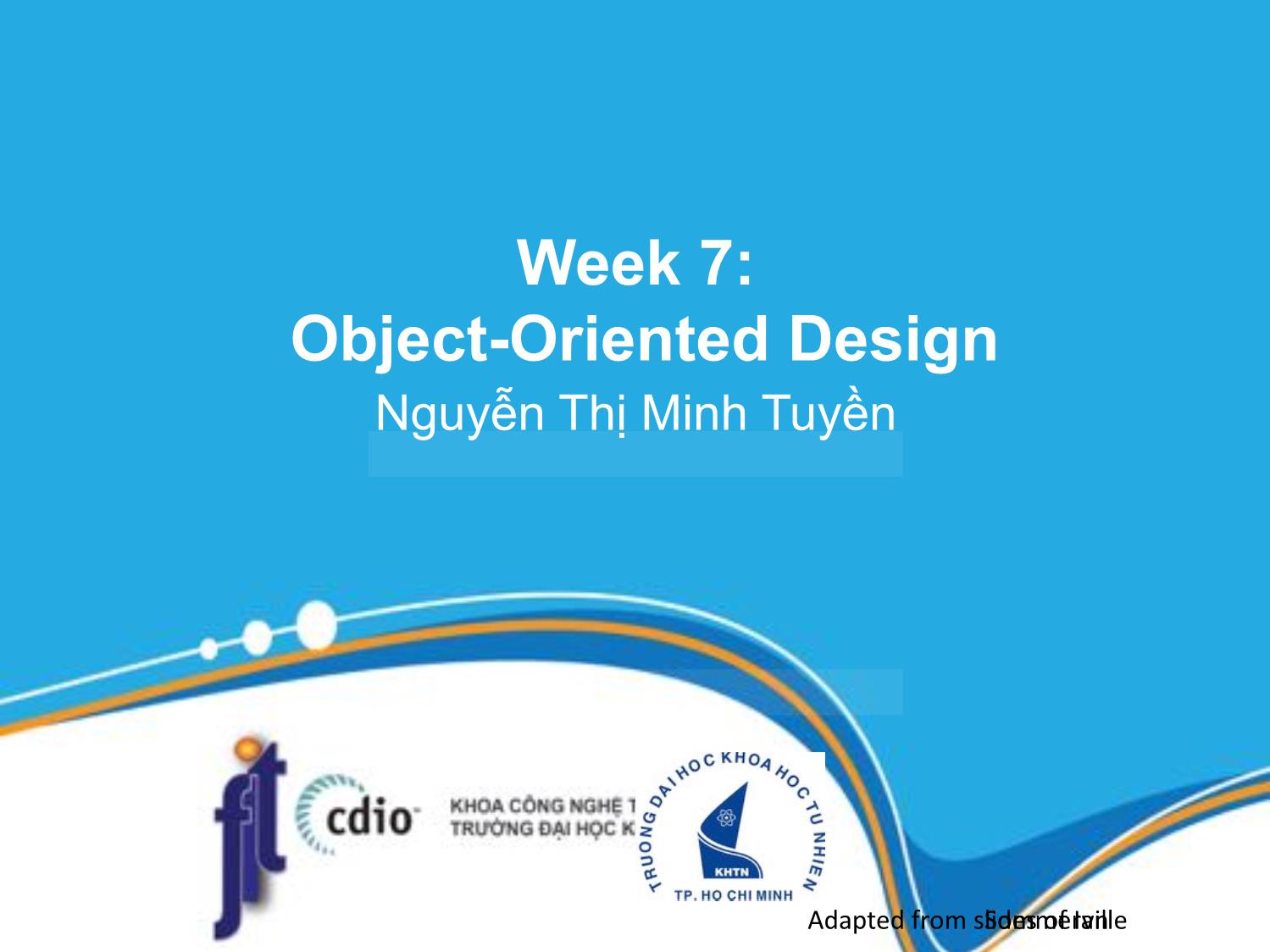
Trang 1
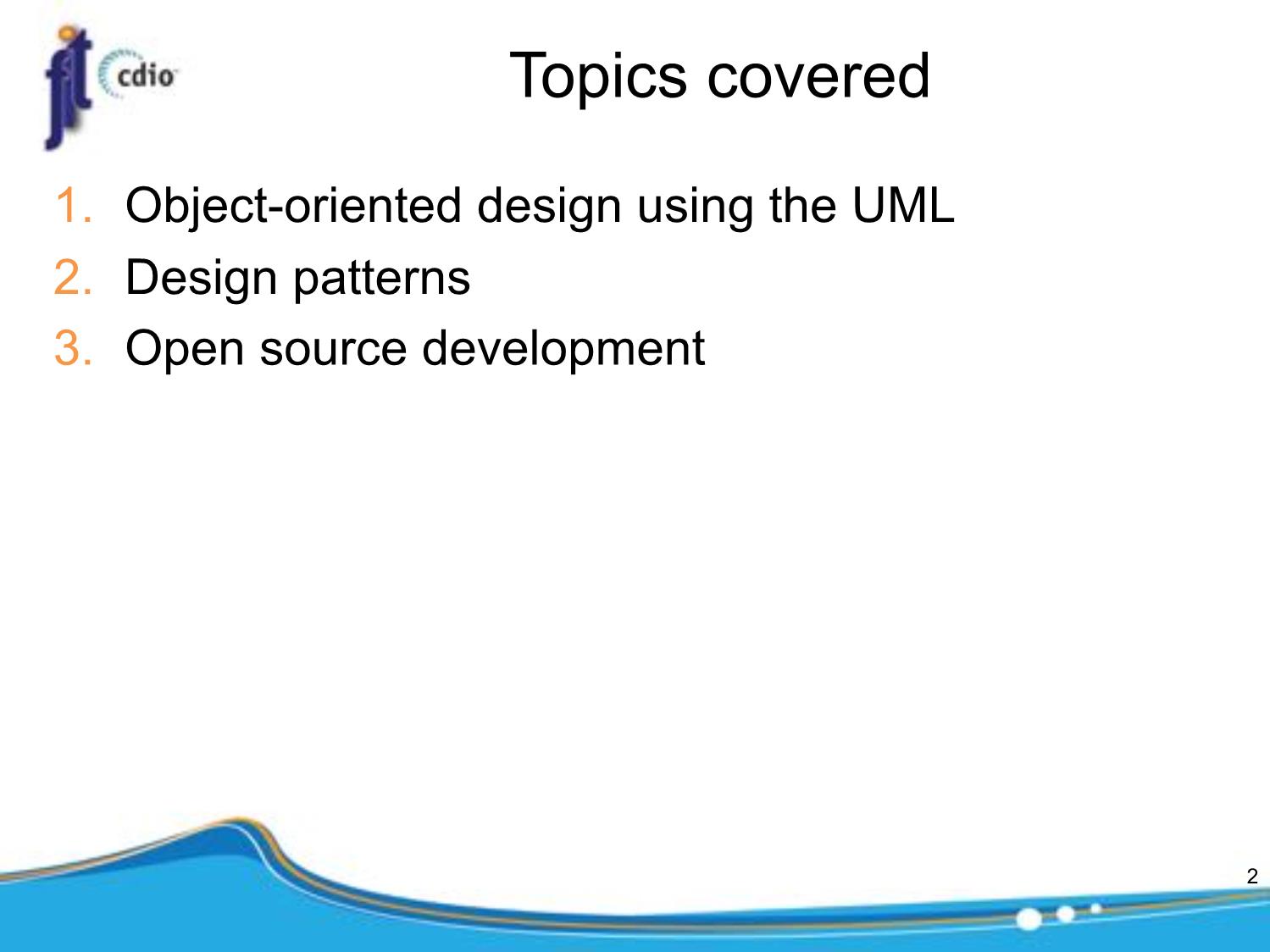
Trang 2
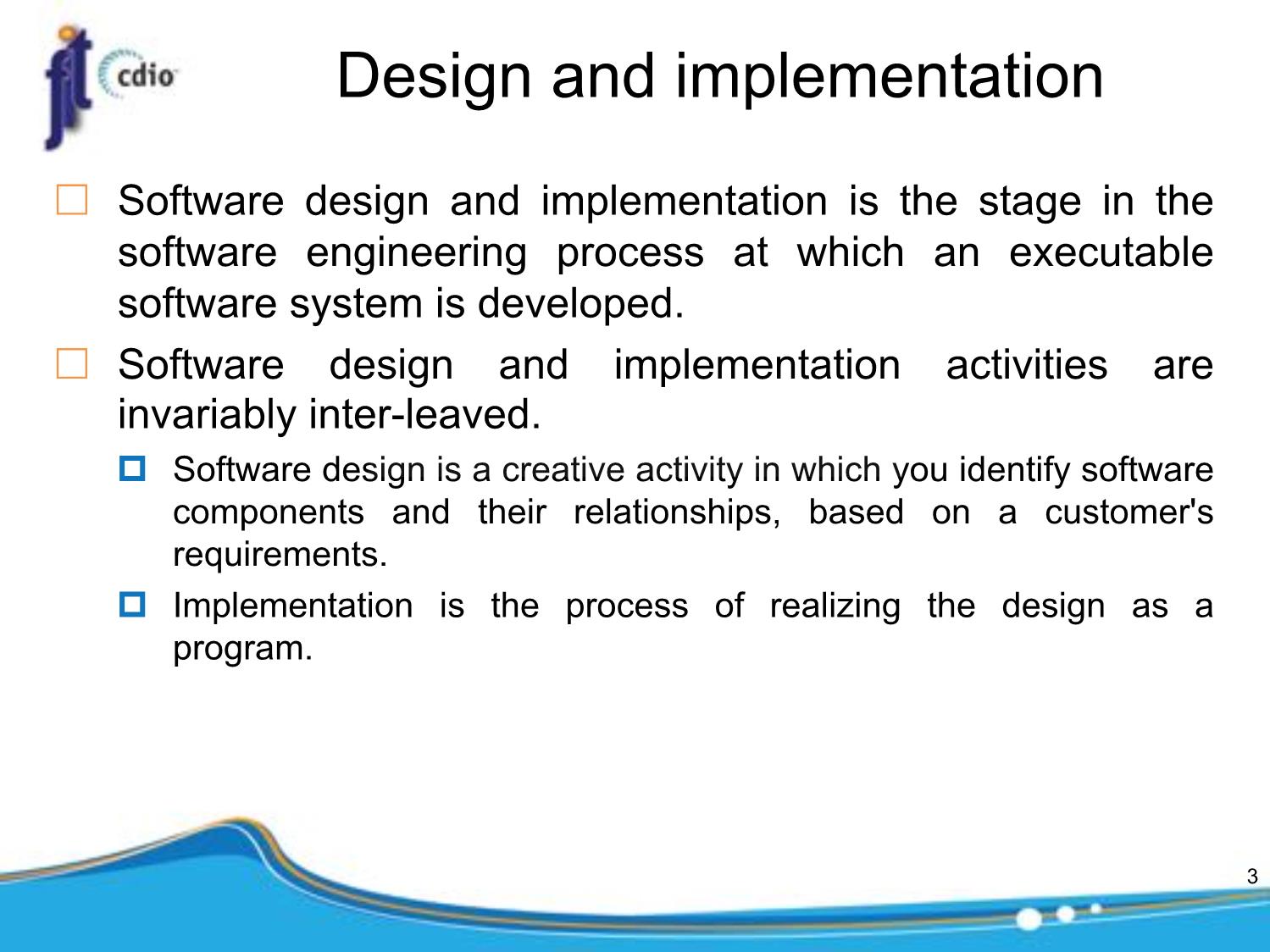
Trang 3
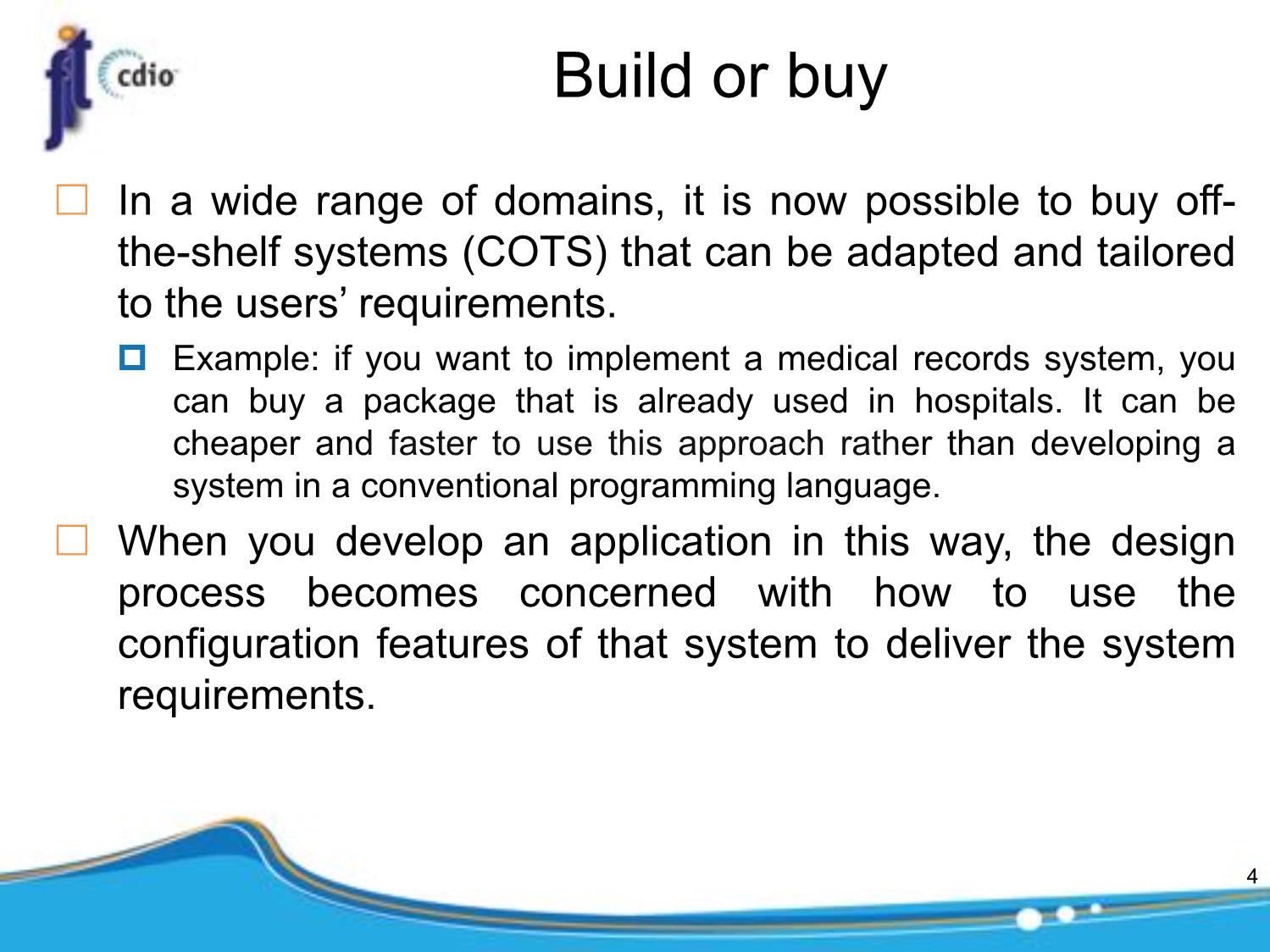
Trang 4

Trang 5
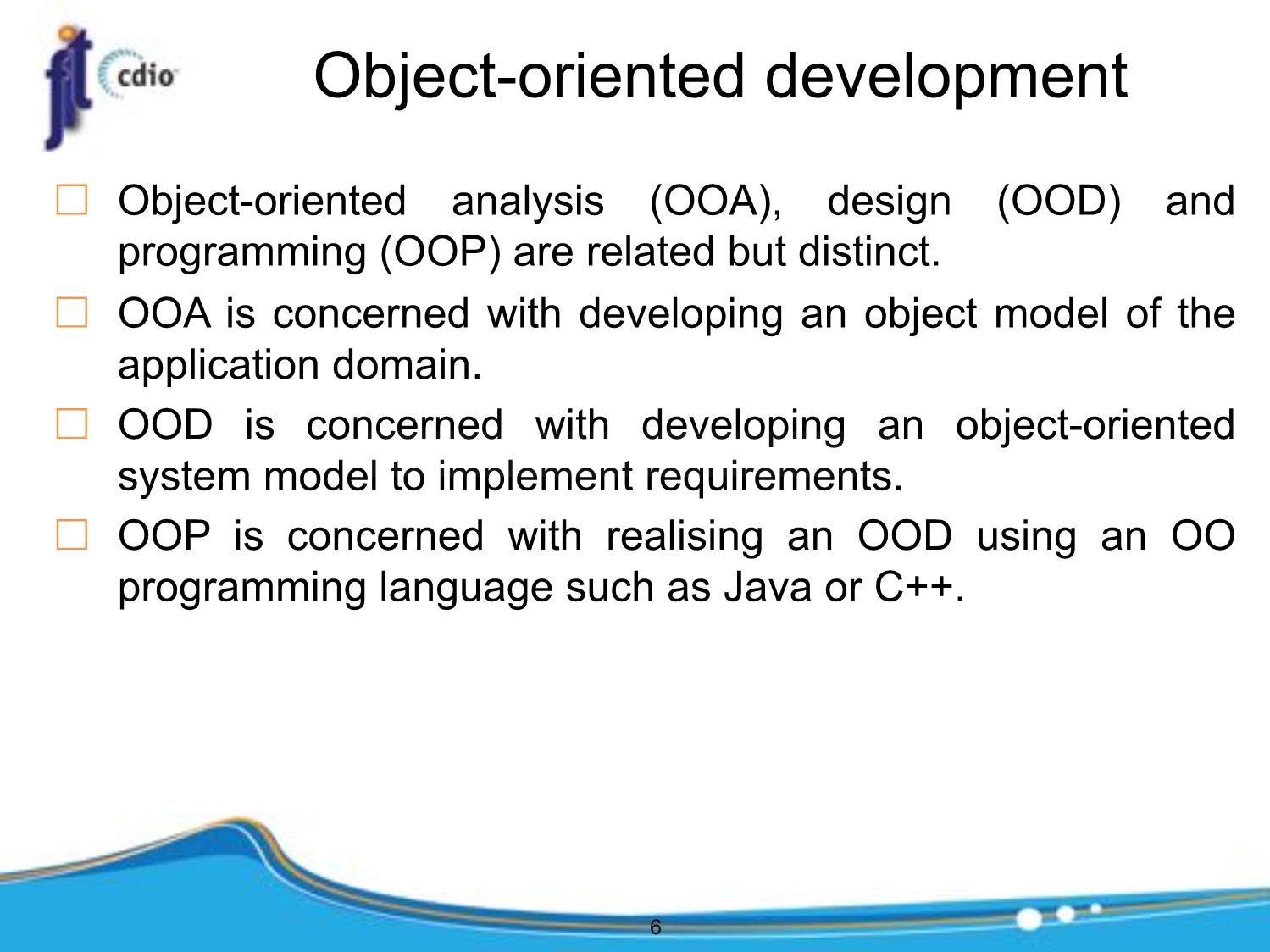
Trang 6
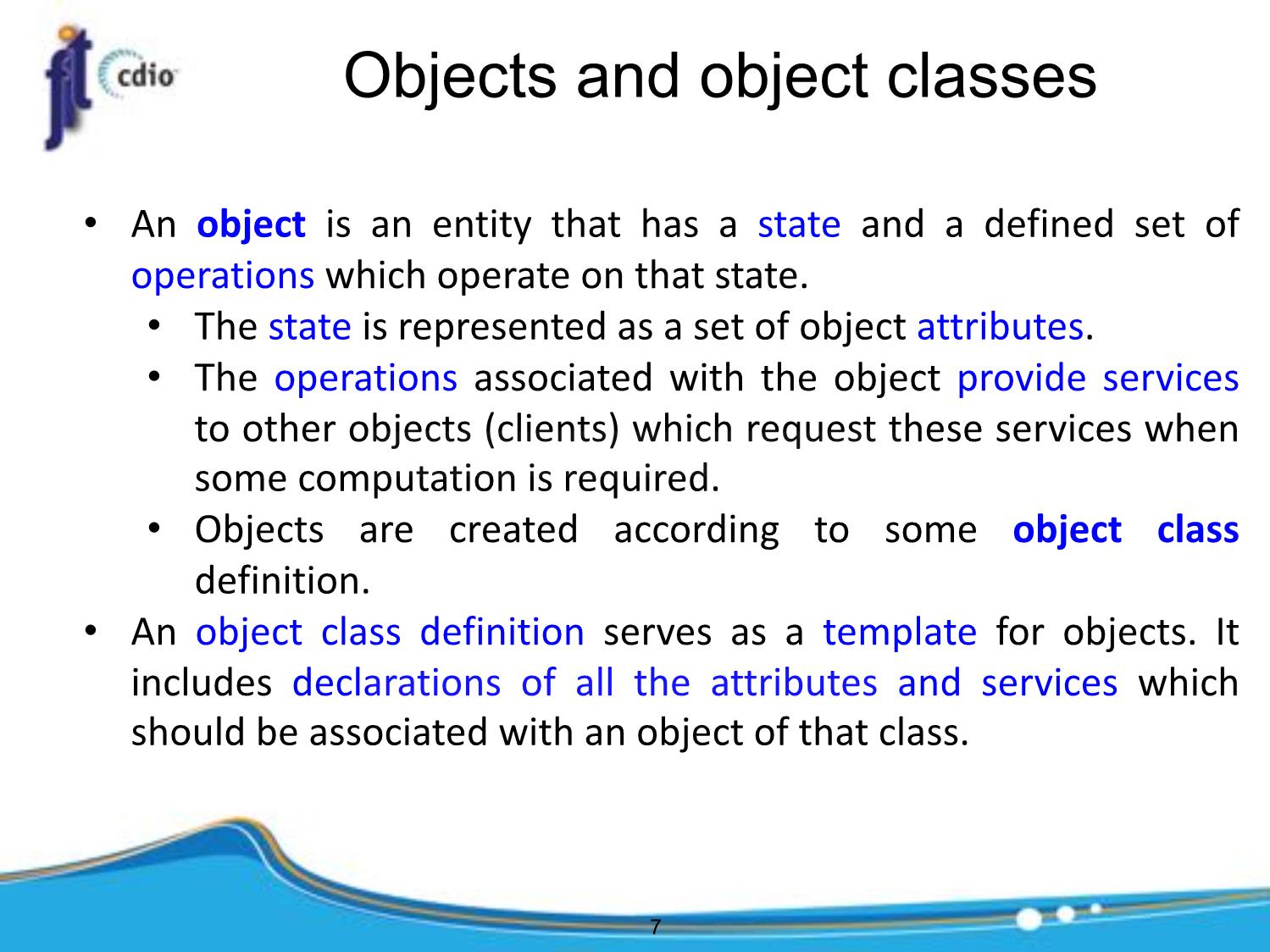
Trang 7

Trang 8
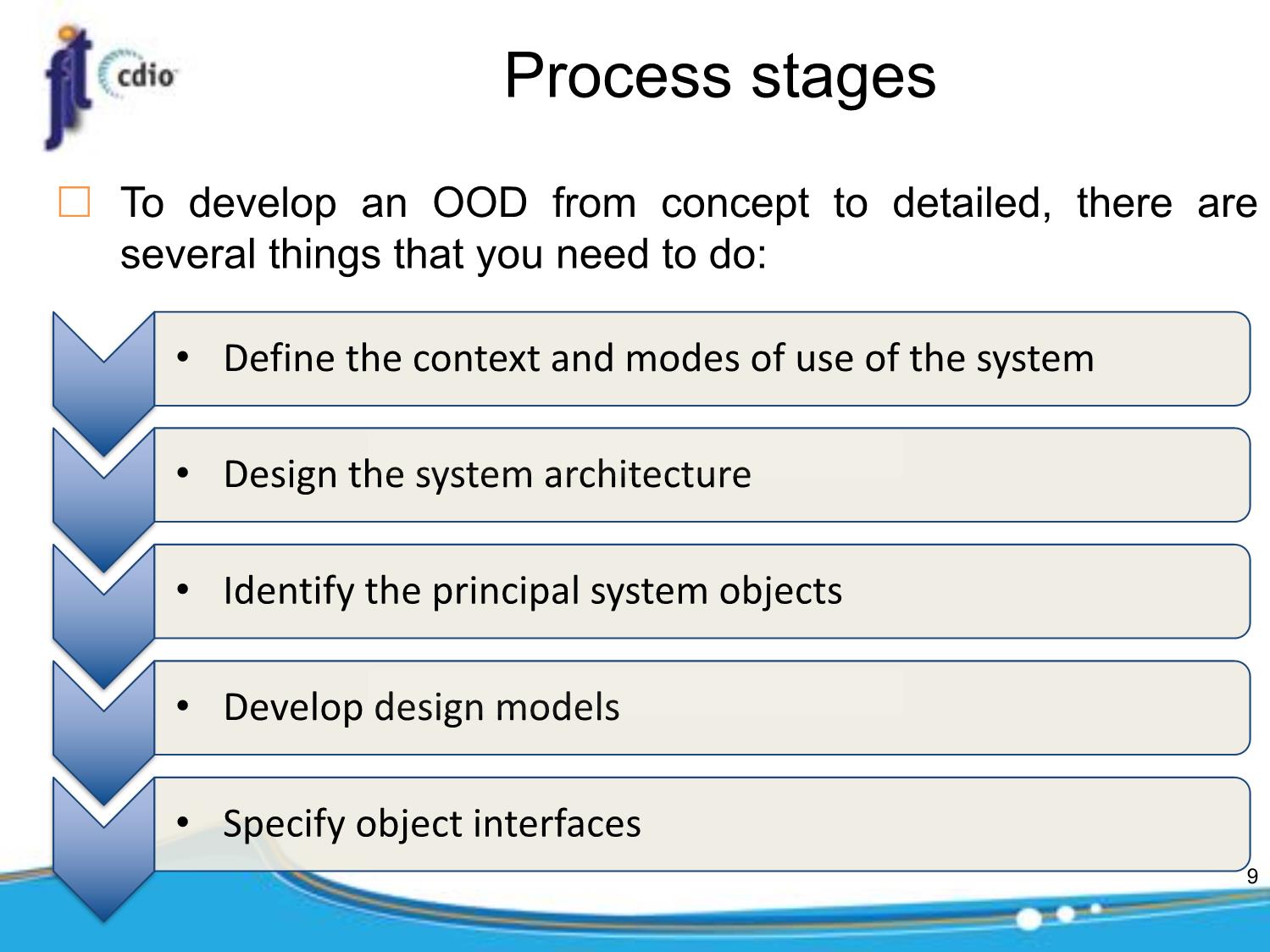
Trang 9
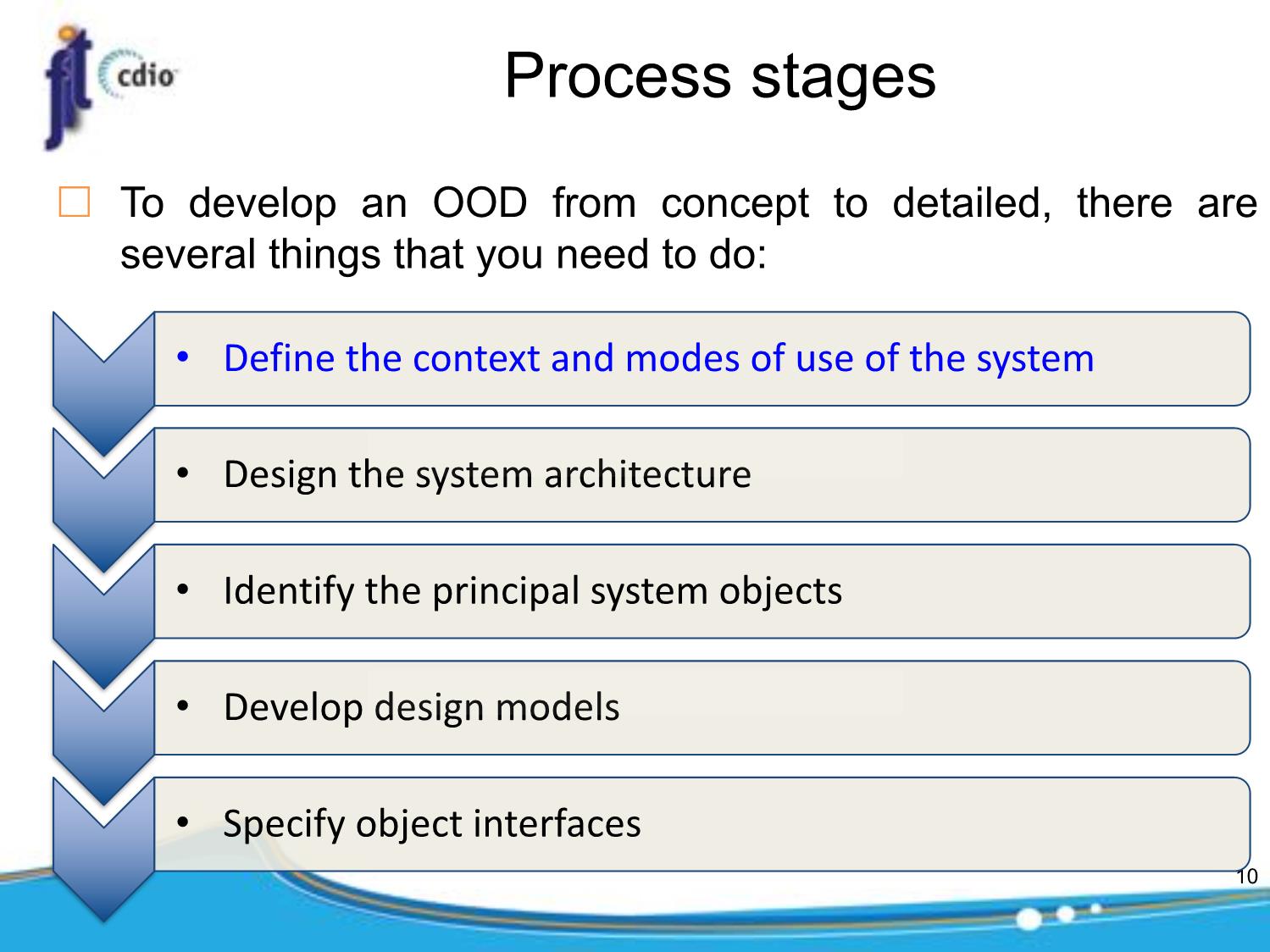
Trang 10
Tải về để xem bản đầy đủ
Bạn đang xem 10 trang mẫu của tài liệu "Bài giảng Introduction to Software Engineering - Week 7: Object-Oriented design - Nguyễn Thị Minh Tuyền", để tải tài liệu gốc về máy hãy click vào nút Download ở trên
Tóm tắt nội dung tài liệu: Bài giảng Introduction to Software Engineering - Week 7: Object-Oriented design - Nguyễn Thị Minh Tuyền
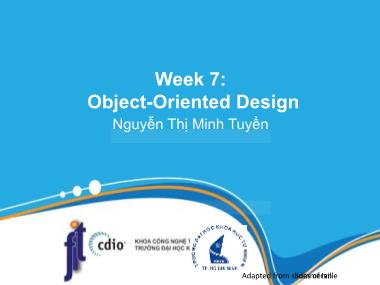
of the data.
Response The summarized data is sent to the weather information system.
Comments Weather stations are usually asked to report once per hour but this
frequency may differ from one station to another and may be
modified in the future. 23
Approaches to identification
£ Use a grammatical approach based on a natural language
description of the system.
£ Base the identification on tangible things in the application
domain.
£ Use a behavioural approach and identify objects based on
what participates in what behaviour.
£ Use a scenario-based analysis. The objects, attributes and
methods in each scenario are identified.
24
Weather station description
A weather station is a package of software controlled instruments
which collects data, performs some data processing and transmits
this data for further processing. The instruments include air and
ground thermometers, an anemometer, a wind vane, a barometer
and a rain gauge. Data is collected periodically.
When a command is issued to transmit the weather data, the
weather station processes and summarises the collected data.
The summarised data is transmitted to the mapping computer
when a request is received.
25
Weather station description
A weather station is a package of software controlled instruments
which collects data, performs some data processing and transmits
this data for further processing. The instruments include air and
ground thermometers, an anemometer, a wind vane, a barometer
and a rain gauge. Data is collected periodically.
When a command is issued to transmit the weather data, the
weather station processes and summarises the collected data.
The summarised data is transmitted to the mapping computer
when a request is received.
26
Weather station object classes
£ Object class identification in the weather station system
may be based on the tangible hardware and data in the
system:
p Ground thermometer, Anemometer, Barometer, etc.
¡ Application domain objects that are ‘hardware’ objects related to
the instruments in the system.
p Weather station
¡ The basic interface of the weather station to its environment. It
therefore reflects the interactions identified in the use-case
model.
p Weather data
¡ Encapsulates the summarized data from the instruments.
27
Weather station object classes
WeatherStation WeatherData
identifier airTemperatures
groundTemperatures
reportWeather ( )
windSpeeds
reportStatus ( )
windDirections
powerSave (instruments)
pressures
remoteControl (commands)
rainfall
reconfigure (commands)
restart (instruments) collect ( )
shutdown (instruments) summarize ( )
Ground Anemometer Barometer
thermometer
an_Ident bar_Ident
gt_Ident windSpeed pressure
temperature windDirection height
get ( ) get ( ) get ( )
test ( ) test ( ) test ( )
28
Process stages
£ To develop an OOD from concept to detailed, there are
several things that you need to do:
• Define the context and modes of use of the system
• Design the system architecture
• Identify the principal system objects
• Develop design models
• Specify object interfaces
29
Design models
£ Design models show
p the objects or object classes in a system and
p the relationships between these entities.
£ Static models describe the static structure of the system in
terms of object classes and relationships.
£ Dynamic models describe the dynamic interactions
between objects.
30
Examples of design models
£ Subsystem models
p show logical groupings of objects into coherent subsystems.
£ Sequence models
p show the sequence of object interactions.
£ State machine models
p show how individual objects change their state in response to
events.
£ Other models include use-case models, aggregation
models, generalisation models, etc.
31
Subsystem models
£ Are static models.
£ Shows how the design is organised into logically related
groups of objects.
£ In the UML, these are shown using packages - an
encapsulation construct.
p This is a logical model.
p The actual organisation of objects in the system may be different.
32
Weather station subsystems
Sequence models
£ Are dynamic models.
£ Sequence models show the sequence of object
interactions that take place
p Objects are arranged horizontally across the top;
p Time is represented vertically so models are read top to
bottom;
p Interactions are represented by labelled arrows,
Different styles of arrow represent different types of
interaction;
p A thin rectangle in an object lifeline represents the time
when the object is the controlling object in the system.
34
Sequence diagram describing data
collection
Weather
information system
:SatComms :WeatherStation :Commslink :WeatherData
request (report)
acknowledge
reportWeather ()
acknowledge get (summary) summarize ()
send (report)
acknowledge
reply (report)
acknowledge
35
State diagrams
£ Are dynamic models.
£ Are used to show
p how objects respond to different service requests and
p the state transitions triggered by these requests.
£ Are useful high-level models of a system or an
object's run-time behavior.
£ You don't usually need a state diagram for all of
the objects in the system.
p Many of the objects in a system are relatively simple and
a state model adds unnecessary detail to the design.
36
Weather station state diagram
Controlled
Operation
shutdown() remoteControl()
reportStatus()
restart() Testing
Shutdown Running
transmission done test complete
configuration done
reconfigure()
Transmitting
powerSave()
clock collection
done reportWeather()
Configuring weather summary
complete
Summarizing
Collecting
37
Process stages
£ To develop an OOD from concept to detailed, there are
several things that you need to do:
• Define the context and modes of use of the system
• Design the system architecture
• Identify the principal system objects
• Develop design models
• Specify object interfaces
38
Interface specification
£ Object interfaces have to be specified so that the objects
and other components can be designed in parallel.
£ Designers should avoid designing the interface
representation but should hide this in the object itself.
£ Objects may have several interfaces which are viewpoints
on the methods provided.
£ The UML uses class diagrams for interface specification
but Java may also be used.
39
Weather station interfaces
«interface»
«interface» Remote Control
Reporting
startInstrument(instrument): iStatus
weatherReport (WS-Ident): Wreport stopInstrument (instrument): iStatus
statusReport (WS-Ident): Sreport collectData (instrument): iStatus
provideData (instrument ): string
40
Weather station interface
interface WeatherStation {
public void WeatherStation () ;
public void startup () ;
public void startup (Instrument i) ;
public void shutdown () ;
public void shutdown (Instrument i) ;
public void reportWeather ( ) ;
public void test () ;
public void test ( Instrument i ) ;
public void calibrate ( Instrument i) ;
public int getID () ;
} //WeatherStation
Topics covered
1. Object-oriented design using the UML
2. Design patterns
3. Open source development
42
Design patterns
£ A pattern is a description of the problem and the
essence of its solution.
£ It should be sufficiently abstract to be reused in
different settings.
£ Pattern descriptions usually make use of object-
oriented characteristics such as inheritance and
polymorphism.
43
Pattern elements
£ Name
p A meaningful pattern identifier.
£ Problem description.
£ Solution description.
p Not a concrete design but a template for a design
solution that can be instantiated in different ways.
£ Consequences
p The results and trade-offs of applying the pattern.
44
The Observer pattern
£ Name
p Observer.
£ Description
p Separates the display of object state from the object
itself.
£ Problem description
p Used when multiple displays of state are needed.
£ Solution description
£ Consequences
p Optimisations to enhance display performance are
impractical.
45
The Observer pattern (1)
Pattern name Observer
Description Separates the display of the state of an object from the object
itself and allows alternative displays to be provided. When the
object state changes, all displays are automatically notified
and updated to reflect the change.
Problem In many situations, you have to provide multiple displays of
description state information, such as a graphical display and a tabular
display. Not all of these may be known when the information
is specified. All alternative presentations should support
interaction and, when the state is changed, all displays must
be updated.
This pattern may be used in all situations where more than
one display format for state information is required and where
it is not necessary for the object that maintains the state
information to know about the specific display formats used.
46
The Observer pattern (2)
Pattern name Observer
Solution This involves two abstract objects, Subject and Observer, and two concrete
description objects, ConcreteSubject and ConcreteObject, which inherit the attributes of
the related abstract objects. The abstract objects include general operations
that are applicable in all situations. The state to be displayed is maintained in
ConcreteSubject, which inherits operations from Subject allowing it to add
and remove Observers (each observer corresponds to a display) and to
issue a notification when the state has changed.
The ConcreteObserver maintains a copy of the state of ConcreteSubject and
implements the Update() interface of Observer that allows these copies to be
kept in step. The ConcreteObserver automatically displays the state and
reflects changes whenever the state is updated.
Consequences The subject only knows the abstract Observer and does not know details of
the concrete class. Therefore there is minimal coupling between these
objects. Because of this lack of knowledge, optimizations that enhance
display performance are impractical. Changes to the subject may cause a
set of linked updates to observers to be generated, some of which may not
47
be necessary.
Multiple displays using the Observer
pattern
50
D
A
25
C
ABC D
B 0
Subject
Observer 1 A: 40 Observer 2
B: 25
C: 15
D: 20
48
A UML model of the Observer
pattern
Subject Observer
Attach (Observer) Update ()
Detach (Observer)
for all o in observers
Notify () o -> Update ()
ConcreteSubject ConcreteObserver
return subjectState Update () observerState =
GetState () subject -> GetState ()
subjectState observerState
49
Design problems
£ To use patterns in your design, you need to recognize
that any design problem you are facing may have an
associated pattern that can be applied.
p Tell several objects that the state of some other object has
changed (Observer pattern).
p Tidy up the interfaces to a number of related objects that have
often been developed incrementally (Façade pattern).
p Provide a standard way of accessing the elements in a
collection, irrespective of how that collection is implemented
(Iterator pattern).
p Allow for the possibility of extending the functionality of an
existing class at run-time (Decorator pattern).
50
Topics covered
1. Object-oriented design using the UML
2. Design patterns
3. Open source development
51
Open source development
£ Open source development is an approach to software
development
p the source code of a software system is published and
volunteers are invited to participate in the development process.
£ Free Software Foundation (www.fsf.org)
p "The Free Software Foundation (FSF) is a nonprofit with a
worldwide mission to promote computer user freedom. We
defend the rights of all software users."
£ Open source software extended this idea by using the
Internet to recruit a much larger population of volunteer
developers. Many of them are also users of the code.
52
Open source systems
£ The best-known open source product is the Linux
operating system
p is widely used as a server system and, increasingly, as a desktop
environment.
£ Other important open source products are Java, the
Apache web server and the mySQL database
management system.
53
Open source issues
£ For a company:
p Should the product that is being developed make use of
open source components?
p Should an open source approach be used for the
software’s development?
54
Open source business
£ More and more product companies are using an
open source approach to development.
£ Their business model is not reliant on selling a
software product but on selling support for that
product.
£ They believe that involving the open source
community will allow software to be developed
more cheaply, more quickly and will create a
community of users for the software.
55
Open source licensing
£ A fundamental principle: source code should be freely
available, this does not mean that anyone can do as
they wish with that code.
£ Legally, the developer of the code still owns the code.
p They can place restrictions on how it is used by including legally
binding conditions in an open source software license.
p Some open source developers believe that if an open source
component is used to develop a new system, then that system
should also be open source.
p Others are willing to allow their code to be used without this
restriction. The developed systems may be proprietary and sold
as closed source systems.
56
License models
£ The GNU General Public License (GPL).
p This is a so-called ‘reciprocal’ license
p If you use open source software that is licensed under the GPL
license, then you must make that software open source.
£ The GNU Lesser General Public License (LGPL)
p A variant of the GPL license
p You can write components that link to open source code without
having to publish the source of these components.
£ The Berkley Standard Distribution (BSD) License.
p This is a non-reciprocal license
p You are not obliged to re-publish any changes or modifications
made to open source code. You can include the code in proprietary
systems that are sold.
57
License management
£ Establish a system for maintaining information about open-
source components that are downloaded and used.
£ Be aware of the different types of licenses and understand
how a component is licensed before it is used.
£ Be aware of evolution pathways for components.
£ Educate people about open source.
£ Have auditing systems in place.
£ Participate in the open source community.
58
Questions?
59File đính kèm:
 bai_giang_introduction_to_software_engineering_week_7_object.pdf
bai_giang_introduction_to_software_engineering_week_7_object.pdf

